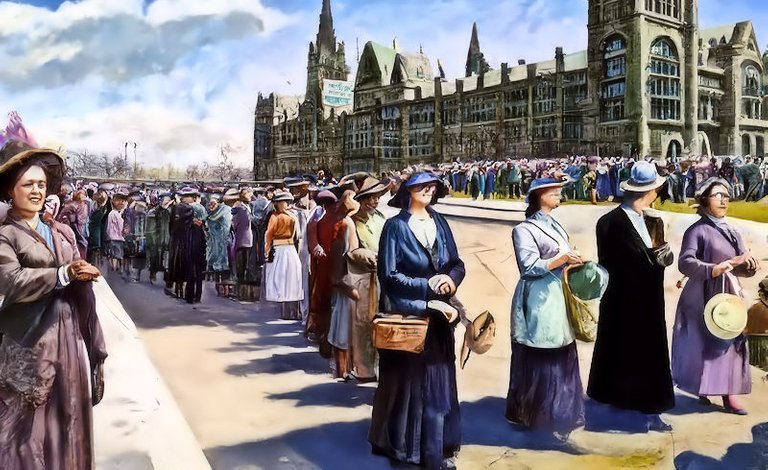Women & Voting Rights in Canada

I thought I’d write a post on the Famous Five, a group of five women activists in the early 1900s who fought to have Canadian women declared persons in 1929. What sparked the fight was men barring women from being appointed to the Canadian Senate on the grounds the definition of ‘person’ in Canadian law didn’t include women.
In researching the post material I decided I’d actually do this in a series of posts. There will be this post exploring the history of voting rights and qualifications to serve in government in this country. I’ll also do separate posts on the Famous Five women and then a post about the ‘Persons Case’. This month being International Women’s History Month seems an appropriate time to do so.
I love when I do some learning in the process of exploring information for a post. This series has been no exception. In modern Canada where women have rights to buy and sell property, hold political office, run businesses and any other choices we deem right for our lives, it’s often forgotten, we didn’t get where we are without a struggle that often continues even today.
Pre-Confederation Canada and Women Voting
In 1791 the Constitutional Act which affected Upper and Lower Canada (what is now Ontario and Quebec) was passed giving ‘persons’ who owned property the right to vote. This Act by the British Parliament didn’t address the gender of persons. There is no evidence of women choosing to vote in British North America.
In 1832 the British Parliament passed the Imperial Reform Act which restricted voting in Britain to men. This influenced political thought in British North America. Immediately, the Legislative Assembly of Lower Canada (Quebec) passed a law restricting women from voting. They were followed by Prince Edward Island (1836) and, New Brunswick (1843).
In the 1844 election in Canada West (now Ontario) at least seven women voted. They were the first recorded instance of women voting in the province and violating common-law tradition. In 1849 the Province of Canada (now Ontario and Quebec) passed a law prohibiting women from voting. In 1851 Nova Scotia joined the list of provinces banning women from voting.
At Confederation, all of the five provinces making up Canada had laws to prohibit women from voting.
Post Confederation Canada
On July 1, 1867 the Confederation of Canada officially formed giving the British colony of Canada the rights to self-government. What the confederation didn’t do was give all Canadians full access to voting and leadership. In fact, Canadian citizenship didn’t exist as a stand alone right.
Rights to Vote and Be Elected in 1867
In 1867 what is now known as the Constitution Act was called the British North America Act (BNA). It formed the terms under which Canada became a self-governing British Colony. Canada at Confederation had a population of about 3.5million people. Only a small part of the population were eligible to vote.
In order to vote, you needed to be:
- over 21 years of age
- a male British subject
- own property with a value of at least $400 or,
- rent a property worth at least $50 a year
Those numbers seem pretty paltry by today’s standards, to express the dollar values in terms of what the equivalent amount in 2021 would be: $400 would equal to property valued at $7,244 and the amount of rent of $50 would be $906. Not a huge sum even in today’s terms but enough to bar a large portion of the population from voting.
To hold office in the House of Commons the additional requirements were:
- hold real property with a value of £400 which equated to $1,962 at that time
- have an annual income of £200 which equated to $981 at that time.
To be appointed to the Canadian Senate the additional requirements were:
- be at least 30 years of age
- own real property worth at least $4,000
- reside in the province or territory for which they were appointed.
As you can see, there was only a small portion of the population able to vote and an even smaller number able to hold office. Women were totally excluded.
Rights to Vote and Hold Office For Women
The Indian Act introduced in 1876 and still largely in force in present day Canada, prohibited all Status Indians from voting federally unless they gave up their status and treaty rights. Female Status Indians were barred from voting in band council elections.
In 1882, the Ontario government granted female property owners who were unmarried or widowed the right to vote on local bylaws. Nova Scotia followed suit on a second attempt in 1884. Ontario expanded the voting rights of female property owners who were unmarried or widowed to municipal elections.
In 1885 the federal government introduced the Electoral Franchise Act. The first draft would have expanded voting rights to unmarried women and widows who own property. It would have also allowed First Nations living on reserves to vote. The final legislation permitted only ‘male persons’ and some Reserve First Nations who met property qualifications the right to vote while barring Chinese Canadians.
In Ontario in 1885 a lone Liberal MPP (Member of Provincial Parliament) introduced the first proposal to give women the vote at the provincial level. It was rare to see a politician supporting the suffrage movement. He introduced it again in 1894. Both attempts failed.
In 1885 the Northwest Territories and in what would become Alberta and Saskatchewan women were banned from voting in or holding office in municipal elections but they were allowed to vote for and become school trustees. New Brunswick in 1886 and Manitoba in 1887 granted unmarried women who met the property requirements the right to vote in municipal elections. In 1890 Manitoba added the right to vote and hold office in school board elections.
Federally in 1895 Member of Parliament (MP) Nicholas Flood Davin, representing Assiniboia West (Alberta) introduced a motion to allow women to vote. It was defeated by a vote of 105 against and 47 for. The arguments against the motion included the notion that women’s place was in the home and our charm and womanliness would be taken away by voting.
Women Voting Provincially
Manitoba in 1916 became the first province to grant women voting rights and the right to hold office. That is women who were British descent or citizenship, were 21 years of age or older and not otherwise disqualified. In the same year, Saskatchewan and Alberta followed suit. British Columbia and Ontario allowed women to vote in 1917.
In 1917, during World War One the federal government extended voting rights to women who were in the armed forces or were relatives of military men. At the same time ‘enemy aliens’ and some pacifist communities were denied the right to vote.
In 1918 women in Nova Scotia were able to vote and hold office. In 1919 New Brunswick and the Yukon Territory granted women the right to vote and hold office while Saskatchewan elected their first female Member of Legislative Assembly (MLA). Quebec added the right in 1920.
Women Voting Federally
The federal government passed legislation to allow women to vote federally in 1918. First Nations women were denied the right to vote unless they gave up status and treaty rights. It would be 1919 before Women would be allowed the right to stand for election to the House of Commons.
It would be 1929 after the Famous Five’s fight in the ‘Persons Case’ when women were finally allowed to be appointed to the Canadian Senate. Not all women though.
In 1948 the Canadian Citizenship Act created a distinct Canadian citizenship, a move toward separating British subjects from a dominant influence in Canadian culture. For the first time the requirement to be a Canadian citizen to hold office in either the House of Commons or the Senate and to be able to vote came into being.
It would be 1950 for First Nations people and 1960 for Inuit people to enjoy the full rights of Canadian citizenship for election, appointment and voting federally.
My Final Thoughts
Several years ago I had the pleasure of being in Ottawa with my niece for a weekend. My niece had often teased me over the years about my feminist views. She grew up in a world where women were able to some extent take for granted things like voting and holding office.
On a bitter cold February afternoon the two of us were walking along the back of the Parliament buildings. We encountered a statue of the Famous Five. My niece asked why there was a statue of old women having a tea party there. I smiled and took some pleasure in explaining to her the fight for women’s rights and to be legally 'persons'.
As we explored the statute I saw her taking an interest and gaining some appreciation of her aunt’s views. The upside is, my niece, those of her generation and since then, can enjoy those rights even if they don’t know the fight it took to get them.
Shadowspub writes on a variety of subjects as she pursues her passion for learning. She also writes on other platforms and enjoys creating books you use like journals, notebooks, coloring books etc.
NOTE: unless otherwise stated, all images are the author’s.
Some of the image work may have been done in Midjourney for which I hold a licence to use the imges commercially.

How to Connect With ShadowsPub:
Twitter: @shadowspub
Instagram: shadowspublishing
Medium: @shadowspublishing
Publishing Website: Shadows Publishing
Nicheless Website: Nicheless & Loving It
(Podcast & subscriptions for: Prompt A Day, PYPT Reminder & Newsletter)
Pimp Your Post Thursday (PYPT):
join us on the DreemPort Discord12pm EST Thursdays

Get eyes on your content and meet new friends. Join DreemPort.

nice)
Millennial Women are in the wonderful position to control their own financial destinies without needing to ask anyone for permission. Which is as it should be.
I know here in the U.S. the Equal Credit Opportunity act 48 years ago was a big milestone for women's financial freedom.
Great article! You were very thorough with your research.
It is natural that there is a kind of distance between generations. It is up to us to educate young minds, I am glad you are taking your time with your niece:)